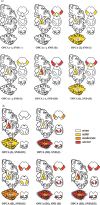Multiple System Atrophy: An Oligodendroglioneural Synucleinopathy1
- PMID: 28984582
- PMCID: PMC5870010
- DOI: 10.3233/JAD-170397
Multiple System Atrophy: An Oligodendroglioneural Synucleinopathy1
Abstract
Multiple system atrophy (MSA) is an orphan, fatal, adult-onset neurodegenerative disorder of uncertain etiology that is clinically characterized by various combinations of parkinsonism, cerebellar, autonomic, and motor dysfunction. MSA is an α-synucleinopathy with specific glioneuronal degeneration involving striatonigral, olivopontocerebellar, and autonomic nervous systems but also other parts of the central and peripheral nervous systems. The major clinical variants correlate with the morphologic phenotypes of striatonigral degeneration (MSA-P) and olivopontocerebellar atrophy (MSA-C). While our knowledge of the molecular pathogenesis of this devastating disease is still incomplete, updated consensus criteria and combined fluid and imaging biomarkers have increased its diagnostic accuracy. The neuropathologic hallmark of this unique proteinopathy is the deposition of aberrant α-synuclein in both glia (mainly oligodendroglia) and neurons forming glial and neuronal cytoplasmic inclusions that cause cell dysfunction and demise. In addition, there is widespread demyelination, the pathogenesis of which is not fully understood. The pathogenesis of MSA is characterized by propagation of misfolded α-synuclein from neurons to oligodendroglia and cell-to-cell spreading in a "prion-like" manner, oxidative stress, proteasomal and mitochondrial dysfunction, dysregulation of myelin lipids, decreased neurotrophic factors, neuroinflammation, and energy failure. The combination of these mechanisms finally results in a system-specific pattern of neurodegeneration and a multisystem involvement that are specific for MSA. Despite several pharmacological approaches in MSA models, addressing these pathogenic mechanisms, no effective neuroprotective nor disease-modifying therapeutic strategies are currently available. Multidisciplinary research to elucidate the genetic and molecular background of the deleterious cycle of noxious processes, to develop reliable biomarkers and targets for effective treatment of this hitherto incurable disorder is urgently needed.
Keywords: diagnostic criteria; glio-neuronal degeneration; multiple system atrophy; oligodendroglial proteinopathy; pathogenesis; prion-like seeding; α-synuclein.
Figures




References
-
- Fanciulli A, Wenning GK (2015) Multiple-system atrophy. N Engl J Med 372, 249–263. - PubMed
-
- Spillantini MG, Goedert M (2016) Synucleinopathies: Past, present and future. Neuropathol Appl Neurobiol 42, 3–5. - PubMed
-
- Jellinger KA (2014) Neuropathology In Multiple System Atrophy, Wenning GK, Fanciulli A, eds. Springer-Verlag; Vienna, pp. 17–55.
Publication types
MeSH terms
Substances
LinkOut - more resources
Full Text Sources
Other Literature Sources

